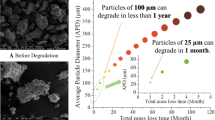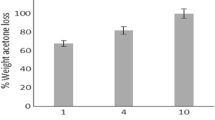Abstract
Purpose. We have evaluated a new process, involving solution-enhanced dispersion by supercritical fluids (SEDS), for the production of polymeric microparticles.
Methods. The biodegradable polymers, Poly (DL-lactide-co-glycolide) : copolymer composition 50:50 (DL-PLG), Poly (L-lactide) (L-PLA), Poly (DL-lactide) (DL-PLA) and Polycaprolactone (PCL), were used for preparation of microparticles using SEDS. Solutions of the polymers in organic solvents were dispersed and sprayed with supercritical CO2. Extraction of the organic solvents resulted in the formation of solid microparticles. The amounts of highly toxic solvents such as dichloromethane (MC) were reduced in the process.
Results. Microparticles were obtained from all polymers. The mean particle size and shape varied with the polymer used. The morphology of the particles was strongly affected by the choice of polymer solvent. Discrete spherical microparticles of DL-PLG were produced with a mean volumetric diameter of 130 μm. The microparticles of the L-PLA were almost spherical, and their size increased from 0.5 to 5 μm as the density of supercritical CO2 decreased. PCL formed microparticles with diameters of 30−210 μm and showed a strong tendency to form films at high pressure.
Conclusions. The SEDS process appears a promising method for production of microparticles from biodegradable polymers without the use of toxic solvents.
Similar content being viewed by others
REFERENCES
M. A. McHugh and V. J. Krukonis (eds.), Supercritical Fluid Extraction, Butterworth Heinemann, Boston, 1994, pp. 1-26.
L. Fredriksen, K. Anton, P. V. Hoogevest, H. R. Keller, and H. Leuenberger. Preparation of liposomes encapsulating water-soluble compounds using supercritical carbon dioxide. J. Pharm. Sci. 86:921-928 (1997).
B. Subramaniam, R. A. Rajewski, and K. Snavely. Pharmaceutical processing with supercritical carbon dioxide. J. Pharm. Sci. 86:885-890 (1997).
C. A. Eckert, B. L. Knutson, and P. G. Denbenedetti. Supercritical fluids as solvents for chemical and materials processing. Nature. 383:313-318 (1996).
J. Bleich, B. W. Müller, and W. Waßmus. Aerosol solvent extraction system — a new microparticle production techniqe. Int. J. Pharm. 97:111-117 (1993).
R. Bodmeier, H. Wang, D. J. Dixon, S. Mawson, and K. P. Johnston. Polymeric microspheres prepared by spraying into compressed carbon dioxide. Pharm. Res. 12:1211-1217 (1995).
J. W. Tom, G. B. Lim, P. G. Denbenedetti, and R. K. Prudhomme. Applications of supercritical Fluids in the Controlled Released of Drugs. In J. F. Brennecke and E. Kiran (eds.) Supercritical Fluid Engineering Science, ACS Symp. Ser. 514, American Chemical Society: Washington, DC, pp. 238-257 (1993).
S. B. Hawthorne. Analytical scale supercritical fluid extraction. Anal. Chem. 62:633-642 (1990).
G. Braun, H. Schmitz, K. Kühlein, and R. Steiner, German patent Appl. No. DE 3323940 A1, 1985.
P. Hubert and O. G. Vitzhum. Fluid extraction of hops, spices and tobacco with supercritical gases. In G. M. Schneider, E. Stahl, and G. Wilke (eds.), Extraction with Supercritical Gases, Verlag Chemie, Weinheim, 1980, pp. 25-443.
M. H. Hanna, P. York, D. Rudd, and S. Beach. A novel apparatus for controlled particle formation using supercritical fluids. Pharm. Res. 12:S141 (1995).
B. Y. Shekunov, S. Palakodaty, P. York, M. Hanna, and G. O. Humphreys. Control of particle morphology using Solution Enhanced Dispersion by Supercritical fluids (SEDS). Pharm. Res. 14:S196 (1997).
J. Bleich and B. W. Müller. Production of drug loaded microparticles by the use of supercritical gases with the aerosol solvent extraction system (ASES) process. J. Microencapsulation 13:131-139 (1996).
P. G. Denbenedetti, J. W. Tom, S. D. Yeo, and G. B. Lim. Application of supercritical fluids for the production of sustained delivery devices. J. Contr. Rel. 24:27-44 (1993).
J. Bleich, P. Kleinebudde, and B. W. Müller. Influence of gas density and pressure on microparticles produced with the ASES process. Int. J. Pharm. 106:77-84 (1994).
J. Bleich and B. W. Müller. Production of drug loaded microparticles by the use of supercritical gases with the aerosol solvent extraction system (ASES) process. J. Microencapsulation 13:131-139 (1996).
F. Ruchatz, P. Kleinebudde, and B. Müller. Residual solvents in biodegradable microparticles. Influence of process parameters on the residual solvent in microparticles produced by the aerosol solvent extraction system (ASES) process. J. Pharm. Sci. 86:101-105 (1997).
M. H. Hanna and P. York, UK patent Appl. PCT/GB94/01426, 1994.
Author information
Authors and Affiliations
Corresponding author
Rights and permissions
About this article
Cite this article
Ghaderi, R., Artursson, P. & Carlfors, J. Preparation of Biodegradable Microparticles Using Solution-Enhanced Dispersion by Supercritical Fluids (SEDS). Pharm Res 16, 676–681 (1999). https://doi.org/10.1023/A:1018868423309
Issue Date:
DOI: https://doi.org/10.1023/A:1018868423309




